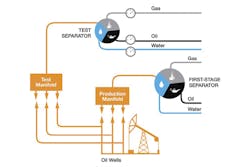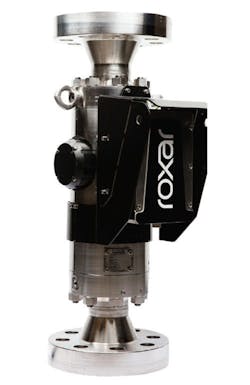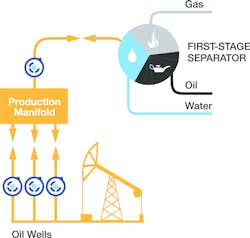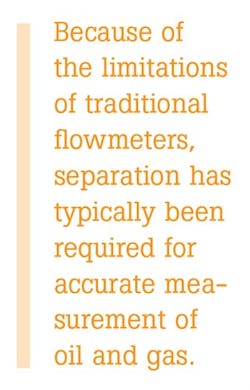Low oil prices are driving increased need for alternative methods of well pad construction. The unique challenges of private mineral rights ownership in the U.S. has always necessitated additional cost and personnel to track and compensate landowners, but the rise of unconventional wells — with long horizontals crossing multiple mineral rights boundaries and a single well held by multiple owners — has driven up the cost of measurement per well. While days were bright at $100 per barrel, well pads bloomed into existence with a separator dedicated to each well, resulting in well pads with five, 10 or more separators, each with its own instruments, transmitters and cabling. However, as prices are expected to remain low in the coming years, operators are driven to find more efficient and cost-effective ways to develop well pads. Those who reinvent production operations will be positioned as the most profitable and healthy operators as the current oversupply inevitably runs back toward a demand-side crunch. Through well pad automation, new technology implementation and production optimization strategies, innovative producers substantially reduce their bottom-line costs on capital and operating expenditures.
On the new technology front, U.S. producers are turning to multiphase flowmeters for the answer to reducing the cost per well pad. The introduction of the multiphase meter substantially reduces the upfront well pad and facilities capital expenses while enabling production optimization workflows that separators are sluggish to support. Only a few years ago in the U.S., multiphase meters were either far too expensive for onshore consideration or inconsistent in operation and data reliability. But as producers evolve to adapt to the lower prices, multiphase flowmeter manufacturers have answered the call for an onshore-priced multiphase meter that delivers reliable, repeatable results.
Multiphase meters provide critical information on a well’s production capabilities.
Why measure
Producers generally need multiphase flow measurement for one or more of the following reasons:
- Allocation — Measurement made to apportion produced fluid of a commingled flow back to royalty owners for payment and to individual wells for production insight.
- Fiscal/custody transfer — Custody transfer refers to a meter that is a point of a commercial transaction between owners, while fiscal metering involves the same need but with the added governmental regulations for accuracy, traceability and taxation requirements. These transactions usually reference requirements set by industry bodies.
- Reservoir and production optimization — Certainty in the quantities that each well produces is critical to reservoir and production understanding. Producers use these data in combination with simulation to anticipate changes in total well and field output. They make adjustments to maintain production at an optimum while considering facility or environmental constraints.
- Flow assurance — Monitoring and controlling the risk for deposits such as scale, wax and hydrate formation in addition to corrosion and erosion monitoring can be a vital function of multiphase measurement. Although scale and wax identification is not the aim of a multiphase meter, detecting small changes in water production is, which can provide invaluable information to an operator who can take action to prevent and reduce the potential for hydrate and scale formation.
For U.S. onshore oil and gas, multiphase meters have recently come under consideration for allocation and optimization thanks to technology advances.
Why multiphase measurement
Traditional methods of measuring oil, gas and water from a well require separation since flowmeters such as positive displacement, turbine, Venturi and Coriolis can tolerate the presence of multiple phases but cannot measure the individual phases when commingled. Substantial effort has been invested in developing correlations and models to enable indirect estimation of the quantities of multiple phases, but the assumptions tend to break down over time as the flow and production characteristics of the well change. Recent advances in Coriolis transmitter technology allow for direct quantification of a single phase when the gas void fraction is less than 15 percent or the liquid void fraction is less than 5 percent. However, these techniques require a favorable flow regime to be effective. If the flow regime or gas-to-liquid ratio changes over time, the technique becomes less accurate. Additionally, these techniques only provide measurement of the dominant phase, liquid or gas, not the complete data set of oil, water and gas flow rates.
Because of the limitations of traditional flowmeters, separation has typically been required for accurate measurement of oil, gas and water. Figure 1 illustrates a conventional test separation arrangement in which two separators and an extensive manifold, including valves and piping, is required. This arrangement requires a significant number of valves, piping and duplicate instrumentation on each separator. Additionally, to change the well under test, actuators with attendant automation are required to avoid the need for continuous manual intervention.
Figure 2. Simplified well pad with direct wellhead measurement
In contrast, Figure 2 shows a well pad design that requires significantly less piping, smaller footprint, and reduced intervention and maintenance using direct measurement with multiphase meters. With multiphase meters, each well can be tested individually and continually without having to redirect eliminates the need for additional automation or manual intervention to test a well. This allows commingling of multiple well pads and consolidation of separation facilities at a central gathering facility.
A third variant on the well pad arrangement would keep the manifold from Figure 1 and simply replace the test separator with a single multiphase flowmeter. This is particularly beneficial for operators who seek to reduce weight and footprint for offshore installations or in onshore cases in which land is at a premium. The multiphase meter in this arrangement provides the benefit of reduced residence time. A test separator typically has a substantial associated volume and requires an hour or more to cycle out fluids from the previous well, followed by several hours of production to obtain an accurate snapshot of production from the well under test. With a multiphase flowmeter, that required time to cycle to the next well is substantially reduced, requiring minutes instead of hours. This allows an operator to test more wells, more frequently with less uncertainty, improving the usability and resolution of the data for reservoir and production engineers.
Multiphase measurement advances
While premier multiphase meter manufacturers earned their stripes in the offshore and subsea arenas, market condition changes are driving efficiency into the manufacturing of multiphase meters, delivering the expertise honed for the challenges of offshore at a price point suitable for the onshore unconventional plays. The latest offerings boast flexible, modular platforms that allow producers to purchase only the multiphase modules required to achieve desired accuracy and performance range. The modularity, coupled with advances in the underlying first principles models, allows many producers to select and operate a multiphase meter without the gamma module, eliminating concerns surrounding transport and upkeep of radiation sources. Additionally, verification routines in the software continuously check conditions to ensure well characteristics are within the calibrated range of the meter and provide real-time updates to remote operators when conditions change, which provides additional confidence in the measurement.
Example: Onshore multiphase meter use
Safety. In a case from Kazakhstan, an operator required highly accurate, real-time measurement for reservoir management in challenging high hydrogen sulfide (H2S) conditions, with H2S levels reaching up to 18 percent. Using multiphase meters, the operator minimized personnel exposure to the environment while meeting the well data needs for the project.
Efficiency. In Central America, an operator required well test data on a more frequent basis than provided by mobile test separators. A truck-mounted multiphase meter test skid was developed that increased the frequency of well testing, eliminated the need to flare and supported the operators with quality data with which to optimize production.
Cost-effectiveness. In a recent case in the U.S., an operator in the Bakken region shared that the use of a multiphase meter in lieu of a separator/ heater treater would save an average of 50 percent of the total capital expense for the well pad. Once the company develops comfort with the technology, the workload per person per well equipped with multiphase is expected to be roughly half that of a separator-equipped well. That improved efficiency of personnel enables absorption of growth in the coming years with existing staff.
Future of the well pad
As oil and gas producers evolve their operations to deliver high-quality, reliable and real-time data cost-effectively, multiphase meters prove to be an exciting enabler of that vision. Delivering reliable data with lower capital costs for the facility, the new generation of modular meters has the flexibility to meet the changing needs of the well over the life of the reservoir.
Laura Schafer is the vice president of oil and gas for Emerson Flow. With more than 15 years of experience in the oil and gas industry, Schafer joined Emerson in 2012 with a focus on extending flow measurement applications in oil and gas. Her experience spans from drilling and completions to production. She holds Bachelor of Science and Master of Science degrees in chemical engineering from the Colorado School of Mines.







